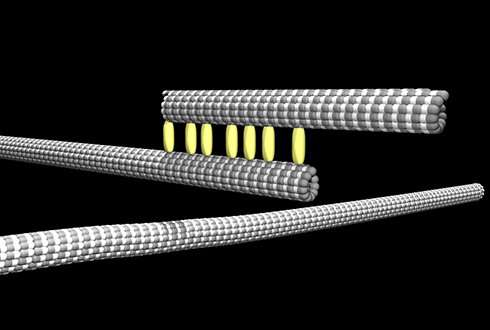Proteins provide forces in cells by acting like microscopic gas springs

Together with colleagues in Germany and Amsterdam, researchers at the Laboratory of Cell Biology of Wageningen University have shown how the disorderly movement of proteins provides directed forces in cells. The proteins work like a gas spring, and in their biological environment they behave according to one of the most important laws of physics. The researchers published their study in the journal Cell.
A compressed gas in a gas spring expands because the gas molecules then have more possibilities to arrange themselves in space: their entropy increases. According to the researchers, proteins in living cells that are 'confined' in the space between two filaments of the cytoskeleton generate forces through this same physical mechanism. Surprisingly, these forces – only a few piconewtons (10-12 newton) in magnitude – can be described exactly with the ideal gas law, which was formulated in 1834.
Microtubules
The researchers demonstrated experimentally that the forces are sufficient to cause long cytoskeleton filaments, called microtubules, to slide past each other. This movement of microtubules is crucial in many cellular processes including cell division in plants and animals. For cell division to occur, microtubules build the 'spindle' that segregates two sets of chromosomes to the new cells. The forces needed for this important biological process are generated in part by the fundamental physical phenomenon of entropy.
More information: "Diffusible Crosslinkers Generate Directed Forces in Microtubule Networks." DOI: dx.doi.org/10.1016/j.cell.2015.01.051
Journal information: Cell
Provided by Wageningen University



















